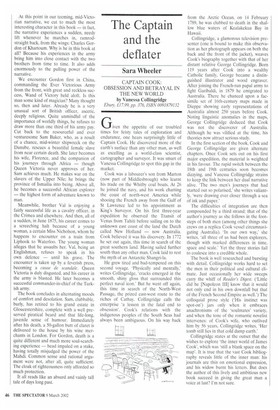The Captain and the deflater
Sara Wheeler
CAPTAIN COOK: OBSESSION AND BETRAYAL IN THE NEW WORLD by Vanessa Collingridge
Ebuty, £17.99, pp. 376, ISBN 0091879132
Given the appetite of our troubled times for feisty tales of exploration and endurance, one hears surprisingly little of Captain Cook. He discovered more of the earth's surface than any other man, as well as excelling as a world-class scientist, cartographer and surveyor. It was smart of Vanessa Collingridge to spot this gap in the market.
Cook was a labourer's son from Marton (now part of Middlesbrough) who learnt his trade on the Whitby coal boats. At 26 he joined the navy, and his work charting the coast of north-west America while shooing the French away from the Gulf of St Lawrence led to his appointment as King's Surveyor. On his first three-year expedition he observed the Transit of Venus from Tahiti before sailing on to the unknown east coast of the land the Dutch called New Holland — now Australia. Cook believed it was his discovery. In 1772 he set out again, this time in search of the great southern land. Having sailed further south than any other man, Cook laid to rest the myth of an Antarctic Shangri-la.
He grew tired and bad-tempered on this second voyage. 'Physically and mentally,' writes Collingridge, 'cracks emerged in the smooth, shiny gloss that surrounded this perfect naval icon.' But he went off again, this time in search of the North-West Passage, the prized east-west route to the riches of Cathay. Collingridge calls the enterprise 'a lesson in the fatal end to obsession'. Cook's relations with the indigenous peoples of the South Seas had always been ambiguous. On his way back from the Arctic Ocean, on 14 February 1789, he was clubbed to death in the shallow blue waters of Kealakekua Bay in Hawaii.
Collingridge, a glamorous television presenter (one is bound to make this observation as her photograph appears on both the back and the front of the jacket), weaves Cook's biography together with that of her distant relative George Collingridge. Born 119 years after Cook into a wealthy Catholic family, George became a distinguished illustrator and wood engraver. After joining the French-run papal army to fight Garibaldi, in 1879 he emigrated to Australia. There he chanced upon a facsimile set of 16th-century maps made in Dieppe showing early representations of Australia almost 250 years before Cook. Noting linguistic anomalies in the maps, George Collingridge deduced that Cook was not the discoverer of Australia. Although he was vilified at the time, his theories now attract serious study.
In the first section of the book, Cook and George Collingridge are given alternate chapters. Once Cook sets out on his first major expedition, the material is weighted in his favour. The rapid switch between the 18th and 19th centuries soon becomes dizzying, and Vanessa Collingridge strains to keep the link between her dual narrative alive. 'The two men's journeys that had started out so polarised,' she writes valiantly, 'were drawing ever closer through a sea of ink and paper.'
The difficulties of integration are then compounded by a third strand: that of the author's journey as she follows in the footsteps of both men (among other things she crews on a replica Cook vessel circumnavigating Australia). 'In our own way,' she writes, 'all three of us had been explorers, though with marked differences in time, space and scale.' Yet the three stories fail to coalesce into a credible whole.
The book is well researched and bursting with detail. Collingridge works hard to set the men in their political and cultural climate. Just occasionally her wide sweeps carry the whiff of Reader's Digest. (`Little did he [Napoleon III] know that it would not only end in his own downfall but that of the French Second Empire as well.') The colloquial prose style (-His instinct was spot-on') jars only when it embraces anachronisms of the `soulmates' variety, and when the tone of the romantic novelist intervenes: of Cook's wife, who outlived him by 56 years, Collingridge writes, 'Her tomb still lies in that cold damp earth.'
Collingridge states at the outset that she wishes to explore 'the inner world of James Cook', which was 'still a blank space on the map'. It is true that the vast Cook bibliography reveals little of the inner man: his journals are thin on emotional expression, and his widow burnt his letters. But does the author of this lively and ambitious new book succeed in giving the great man a voice at last? I'm not sure.














































































 Previous page
Previous page